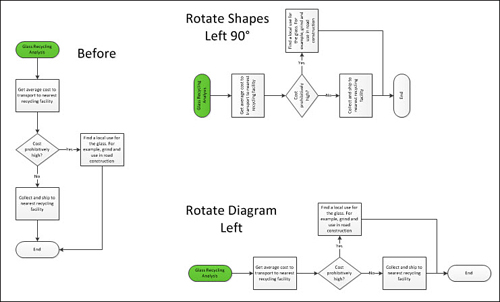Distributing Shapes
If you need a set of shapes to be equally spaced,
the distribute functions can help. You find them in the Space Shapes
group within the Position drop-down. For veteran PC users, “space”
seems to be the Visio 2010 verb for what used to be called “distribute.”
Figure 10
shows a practical application of shape distribution (spacing). The left
half of the image shows horizontal and vertical reference line shapes
that aren’t nicely distributed. The goal is to create a grid so that a
coordinator can communicate locations within a building to contractors;
for example, “The elevator at C-4 is due for regular maintenance.”

Manually positioning the reference shapes is
difficult and time consuming, and the Dynamic Grid’s uniform spacing
features aren’t quite right for this task. You could use the Size &
Position dialog to numerically specify locations for the shapes, but
the Space Shapes functions, make this a simple task.
The key is to place the shapes roughly in order and then make sure the first and last shapes span the appropriate region. In Figure 10,
shapes 1 and 6 are at the horizontal extremes of the plan, and shapes A
and F are at the vertical extremes. The remaining shapes just need to
be spaced equally between them.
To distribute each set of shapes, simply select all
shapes that you wish to equally space, and then click Position, Space
Shapes, Distribute Horizontally, or Distribute Vertically. The
distribute functions calculate the necessary shape-to-shape spacing
required to evenly distribute the selected shapes between the extremes.
If you need to space the shapes a specific distance
from each other, you can use the Position, Spacing Options command.
This presents a dialog where you enter precise horizontal and vertical
measurements. Oddly, it seems to work only with connected diagrams; it
would be a great feature for organizing grids of nonconnected shapes,
too!
|
You
might have noticed two familiar-sounding items under Space Shapes that
I haven’t discussed: Auto Align and Auto Space. They simply break down
Auto Align & Space function into separate components so that you
can line up shapes or space them equally apart.
|
Rotating Shapes
At the bottom of the Position menu is the Orient
Shapes group with two curiously similar-sounding items: Rotate Shapes
and Rotate Diagram.
The items under Rotate Shapes enable you to rotate a
selection of shapes as a single unit. You can also mirror the shapes in
the horizontal or vertical direction using the flip commands.
Rotate Diagram sounds confusing. Isn’t that the same
as Rotate Shapes? If you are mathematically inclined or an Excel
expert, you will understand that Rotate Diagram transposes shapes. It rotates the positions of the shapes, but not the shapes themselves.
Figure 11 contrasts Rotate Shapes and Rotate Diagram. Note that Rotate Diagram applies only to connected shapes.
